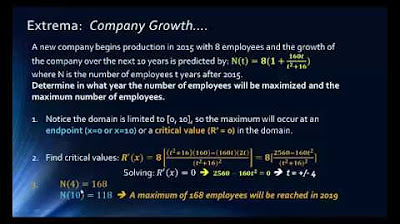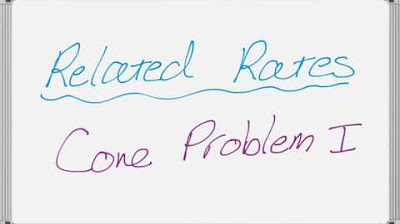Optimization Example 4
TLDRThe video script presents a mathematical problem involving the maximization of material cost efficiency for a rectangular storage container with a fixed volume of 10 cubic meters. The container has a base length twice its width and an open top. The problem is solved by setting up an equation for the height in terms of the width and then deriving a cost function based on the material costs for the base and sides. The minimum cost is found by taking the derivative of the cost function, setting it to zero, and solving for the width. The critical point is confirmed to be a minimum by testing other values of width, leading to the conclusion that the cheapest container is produced when the width is approximately 1.65 meters.
Takeaways
- 📏 The problem involves a rectangular storage container with an open top and a desired volume of 10 meters cubed.
- 📐 The base length is twice the width, establishing a relationship of 2x for length and x for width.
- 🔢 The height (h) is determined by the volume formula (2x^2 * h = 10), resulting in h = 5x^(-2).
- 💰 The cost of materials is based on the surface area of the sides and base, with the base costing $10 per square meter and the sides costing $6 per square meter.
- 🧱 The total cost function is derived as 20x^2 + 180x^(-1), without the need to account for the top since it's open.
- 📈 To find the cheapest container, the cost function is differentiated to find the critical points, leading to c'(x) = 40x - 180x^(-2).
- 🎓 Setting the derivative equal to zero to find the minimum point, 2x - 9x^(-2) = 0, which simplifies to x^3 = 9/2 or x = (9/2)^(1/3).
- 🔍 The minimum point's nature (whether it's a minimum or maximum) can be confirmed by testing other x values or by using the second derivative.
- 🤔 The script suggests that if there's only one critical point and the goal is to find the cheapest container, this point is likely the minimum.
- 🌐 The final answer is x ≈ 1.65, which means the cheapest container is achieved when the width is approximately 1.65 meters, and the length is 3.3 meters (twice the width).
Q & A
What is the main objective of the problem discussed in the script?
-The main objective is to find the cheapest way to construct a rectangular storage container with a volume of 10 meters cubed, given the cost of materials for the sides and base.
How is the volume of the storage container calculated?
-The volume of the storage container is calculated by multiplying the length, width, and height of the container. Since the length is twice the width, and the volume is 10 cubic meters, the height can be determined as h = 10 / (2x^2).
What are the costs associated with the materials for the base and sides of the container?
-The material for the base of the container costs $10 per square meter, while the material for the sides costs $6 per square meter.
How is the total cost of the container calculated?
-The total cost of the container is calculated by summing the cost of the base and the sides. The cost of the base is 10 times the area of the base (2x^2), and the cost of the sides is calculated based on their individual areas and the given cost per square meter.
What is the expression for the cost function in terms of x?
-The cost function in terms of x is given by C(x) = 20x^2 + 180x^(-1).
How is the minimum cost determined?
-The minimum cost is determined by taking the derivative of the cost function, setting it equal to zero, and solving for x. The critical point found is then tested to confirm whether it represents a minimum.
What is the critical point found in the script?
-The critical point found in the script is x = (9/2)^(1/3), which is approximately 1.65.
How can we confirm that the critical point is indeed a minimum?
-We can either take the second derivative and check for concavity upwards, or we can test the critical point by comparing the cost function values around it to ensure that it is indeed a minimum.
What is the significance of the open top of the container?
-The open top of the container means that there is no material cost associated with the top surface, which simplifies the cost calculation and reduces the overall material requirements.
How does the width and length relationship affect the cost?
-Since the length is twice the width (2x), this relationship directly impacts the calculation of the volume and the surface area of the container, which in turn affects the total cost of the materials.
What is the final cost of the cheapest container?
-The final cost of the cheapest container is not explicitly stated in the script, but it can be calculated by substituting the critical point x = 1.65 back into the cost function C(x).
Outlines
📏 Optimization Problem - Rectangular Storage Container
The video begins with the presenter introducing an optimization problem involving a rectangular storage container with a specified volume of 10 meters cubed and a base length twice the width. The container has an open top. The presenter starts by visualizing the container and establishing the relationship between its dimensions, using 'x' to represent the width. The length is expressed as 2x, and the height 'h' is determined by the volume constraint, which leads to h = 5x^(-2). The objective is to find the cheapest cost of materials for the container. The cost of the base material is $10 per square meter, and the sides cost $6 per square meter. The presenter sets up an equation for the total cost as a function of 'x', incorporating the areas of the base and the sides, and simplifies it to C(x) = 20x^2 + 180x^(-1).
📈 Cost Minimization and Derivative Analysis
In the second paragraph, the presenter simplifies the cost function further to C(x) = 20x^2 + 180x^(-1) and explains the next steps to find the minimum cost. The derivative of the cost function with respect to 'x' is taken, resulting in C'(x) = 40x - 180x^(-2). By setting the derivative equal to zero to find the critical points, the presenter solves for 'x' and finds that x = (9/2)^(1/3), which is approximately 1.65. This value of 'x' corresponds to the minimum cost, suggesting that the cheapest container is achieved when the width is approximately 1.65 meters. The presenter also discusses the use of the second derivative to confirm the minimum and provides a practical tip for identifying minimum points without complex calculations.
Mindmap
Keywords
💡Maximization or Minimization
💡Rectangular Storage Container
💡Volume
💡Constraint
💡Cost Function
💡Derivative
💡Optimization
💡Surface Area
💡Critical Point
💡Second Derivative
💡Cube Root
Highlights
The problem involves a rectangular storage container with a specific volume requirement and material costs for its construction.
The container has an open top and its base length is twice its width, creating a relationship between the dimensions.
The volume of the container is set to be 10 meters cubed, providing a constraint for the mathematical model.
The cost of materials for the sides and base of the container are different, complicating the cost calculation.
The height of the container is expressed in terms of the width (x), using the volume constraint.
The total cost of the container is derived as a function of x, including the areas of the base and sides.
The cost function is simplified to a more manageable form for further analysis.
To find the cheapest container, the derivative of the cost function is taken to identify critical points.
Setting the derivative equal to zero helps in finding the minimum cost point.
Solving the derivative equation yields the optimal width (x) for the cheapest container.
Further confirmation of the minimum point can be done by testing other x values or using the second derivative.
The problem-solving approach combines geometrical relationships, algebraic manipulation, and calculus.
The final cost function is a quadratic equation in terms of x, which is used to determine the minimum cost.
The method can be applied to optimize costs in real-world scenarios, such as manufacturing and construction.
The solution process demonstrates the practical application of mathematical optimization techniques.
The problem and its solution showcase the importance of mathematical modeling in optimizing resource usage and costs.
The use of calculus, specifically derivatives, is crucial in finding the minimum cost for the container.
The solution provides a clear example of how mathematical optimization can lead to cost-effective designs.
Transcripts
Browse More Related Video

Optimization: cost of materials | Applications of derivatives | AP Calculus AB | Khan Academy

Calculus grade 12: Optimisation Practice

Maximization Word Problem #2!

Math1325 10 4 Lecture - Applications for Maximum & Minimum

Related Rates - Filling a Cone Problem

Finding Absolute Extrema (Max/Min) on an Open Interval (a, b)
5.0 / 5 (0 votes)
Thanks for rating: